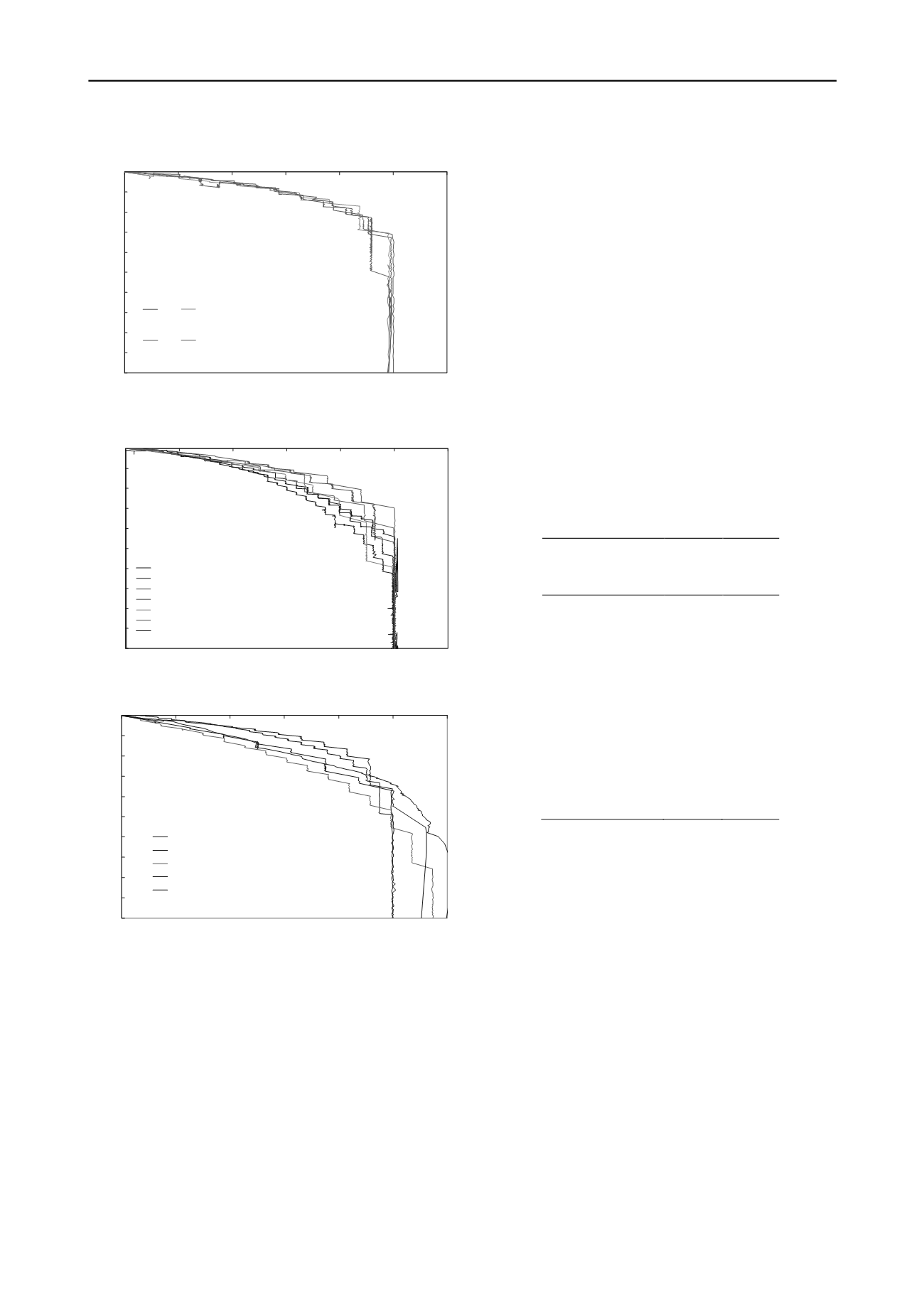
2829
Technical Committee 212 /
Comité technique 212
Proceedings of the 18
th
International Conference on Soil Mechanics and Geotechnical Engineering, Paris 2013
Figure 2. Normalised bored pile test results.
Figure 3. Normalised CFA pile test results.
Figure 4. Normalised displacement pile test results.
4.1.2
Results
–
bored piles
The results from the 4 bored piles gave remarkably consistent
values for
α
in the range 0.5 to 0.55. They all gave a very
similar behaviour, failing at a pile head movement of about
3mm as shown in normalized plot in Figure 2.
4.1.3
Results
–
CFA piles
The 7 CFA piles showed a significant variation in capacity with
control of installation. The ‘normal’ drilling installation
parameters for a clay of this type is around 100mm penetration
per revolution. A lower penetration per revolution increases the
potential for greater smearing of the bore, whilst the converse is
true where higher penetration rates are used.
In the study, rates of 150mm or 120mm, 100mm and 50mm
penetration/revolution were used for the different 300mm and
400mm diameter augers with a common pitch of 350mm
(Skinner et al 2003). These rates were label
led ‘tight’, ‘normal’
and ‘loose’. The capacities found
showed that there was an
increase in
α
for a higher penetration per revolution (Table 3).
The value found could be related to installation (Figure 5). The
worst value obtained (TP13) gave an
α
value close to that of the
‘bored’ piles! The change of α
for CFA piles has potential
benefits for challenging sites, but carries a warning that
preliminary test piles need to be installed with the same
parameters same as working piles, to ensure the design
parameters selected are appropriate. The 3
‘normal’ CFA piles
gave
α
values in the range 0.72-0.75 which are somewhat higher
than the typically used value of 0.6. This may reflect the fact
that low values have been encountered previously and this may
have been a result simply of poor construction control.
They all showed basically similar behaviour, failing at a pile
head movement of between 3 and 5mm, those going to 5mm
showing a slightly more curved response as shown in Figure 3
normalized plots. For the 300mm diameter CFA piles, the
longer piles show the more curved behaviour but these were
also loaded in smaller increments and as a result took longer
times to failure - which may have allowed more shedding of
load down the pile as local failure occurred at shallow depths.
The 450mm diameter piles (MC1 and MC2) showed the stiffest
behaviour but were loaded in larger increments and so shorter
times.
Table 3. Derived Alpha values
Pile type
Static
failure
load
(kN)
Alpha
CFA (T33)
700
.84
CFA (T34)
600
.72
CFA (T14)
625
.75
CFA (T13)
325
.52
CFA (T15)
500
.82
CFA (MC1)
1000
.72
CFA (MC2)
1050
.75
Bored (T16)
450
.54
Bored (T40)
225
.51
Bored (T46)
300
.52
Bored (T47)
310
.54
Screw Dispt (T30)
650*
.72
Displacement (T35)
525
.73
Displacement (T36)
300
.65
Driven (TP1)
1000
1.0
Driven (TP2)
950
.95
*interpreted shaft only
4.1.4
Results
–
displacement piles- auger
Auger displacement piles have the advantage of minimal spoil
generation without the noise disadvantage of driven piles.
Within the auger displacement pile category two pile types
were tested, straight forward parallel sided piles with all soil
displaced laterally and ‘screw’ displacement piles where a
screw thread is cut out from the central shaft thereby giving a
larger overall diameter to the pile, still with no soil removal and
using less concrete than a CFA or bored pile of the same
diameter. The normalised results are shown in Figure 4.
The displacement piles (T35 and T36) gave
α
values of 0.65-
0.72 while the screw displacement pile gave an
α
of 0.72 (based
on the external diameter of the screw thread). The screw pile
had a slightly softer response to loading but with the much
larger potential base area and the different potential shaft failure
modes this is not surprising. In the literature the diameter used
to back calculate skin friction values is sometimes taken as a
mean value between the central core and maximum thread
diameter and care should be taken when comparing values as to
the diameter used. The screw pile type tested (Atlas) showed
capacity equivalent to a 600mm diameter CFA pile, with
significantly lower concrete consumption.
0
1
2
3
4
5
6
7
8
9
10
0
0.2
0.4
0.6
0.8
1
1.2
Displacement (mm)
Load / assessed shaft capacity
T16 T40
T47 T46
0
1
2
3
4
5
6
7
8
9
10
0
0.2
0.4
0.6
0.8
1
1.2
Displacement (mm)
Load / assessed shaft capacity
T34
T33
MC2
MC1
T15
T13
T14
0
1
2
3
4
5
6
7
8
9
10
0
0.2
0.4
0.6
0.8
1
1.2
Displacement (mm)
Load / assessed shaft capacity
T35
T36
T30
TP1
TP2


